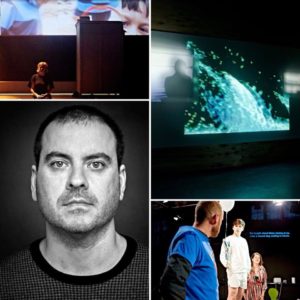
The director of Get the Chance, Guy O’Donnell recently met with Photographer/Videographer/ AV designer and Projection Mapper Jorge Lizalde. They discussed his training in Spain, his most recent work with Lucid Theatre Company on Little Wolf and his thoughts on the arts in Wales.
Hi Jorge, great to meet you can you give our readers some background information on yourself please?
Hi, I am Spanish and was born in Zaragoza and moved 12 years ago to the UK when I finished my art studies in Salamanca and then Madrid. When I arrived in the UK I worked for four years as a cinema projectionist at Vue Cinemas at the Angel (London) as well as The French Institute (London) where the projection is still old school, swapping film reels every hour over two projectors, a job that I loved but digital cinema has killed it. In 2009 I moved to Cardiff and since then I have been freelancing as Photographer/Videographer and most recently as an AV designer and Projection Mapper.
So what got you interested in the arts?
My grandfather Jose Luis Cano (on my mother’s side) was a famous watercolour painter from where I come from, his son, Jose Luis Cano (both my grand father and uncle, share the same name as it’s a Spanish tradition to name your son after your father.) my uncle, is a well known painter/illustrator, he creates the satiric daily drawings on the local newspaper, Heraldo De Aragon. My grandfather had an art studio, known as Studio Cano that’s why I trade commercially with that name, which is my second surname, in Spain we keep both surnames from the father and the mothers side. The different people I encountered at Studio Cano learned different painting styles and disciplines at the studio. I spent a lot of my childhood and teenage years there, painting, drawing, etc. It is where I got ready for my University access as in Spain to study a BA in Fine Arts you need to know how to draw a life model as part of your A Levels. At Uni I learned many different disciplines of painting, sculpture and drawing as studies are quiet traditional, making my own canvas, paints, etc. My father was into photography just as an amateur but his brother was a commercial photographer. I didn’t really got interested in photography until my father passed away 18 years ago and I was passed down his heritage and his equipment at the end of my first year at Uni. In addition, many friends of my parents are ceramists, architects, etc. Art was always around, so I guess it was inevitable that my brother (classical/flamenco guitarist) and myself would finally become involved in the arts as a career.
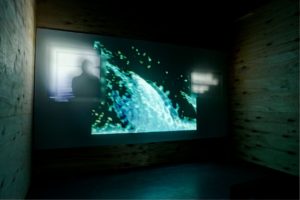
Jorge Lizalde, “Mnemonic” at G39 gallery
You have a wide variety of film and photographic skills. When you are photographing a theatrical production how do you approach the process of taking an image?
With every shot I treat it as individual, my camera settings and focus are manually set so I have total control of the shot. Having started as self-taught on film, before digital photography took over, has helped me to have a good understanding of the tech, so I just have to pay attention to what’s going on in front of me (actor interactions, movements, reactions, expressions etc.) I don’t like to retouch pictures afterwards in post-production, I just readjust the white-balance that sometimes the camera can get wrong. Foe example theatre lights can have new LEDs which can be can be really tricky on temperature and contrast, but what you see on the picture is normally what I initially capture. What I do particularly like is to move around a lot as this gives me some perspective and creates more interesting shots that just an on the spot view from the auditorium. From a dress rehearsal session I can get around 150 usable shots, its then the job of the producer or the person in charge of marketing to choose the final images.
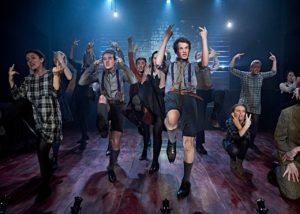
Credit: Gamta School by Jorge Lizalde | studiocano.co.uk
What makes a good image for a theatre production?
A well composed and focused picture of a scenario or situation that through the actors expressions tells you exactly what’s going on. If on top of that it gives you a sense of the stage or space that to me is a hell of a picture.

Credit: Roberto Zucco – August 012 by Jorge Lizalde | studiocano.co.uk
You also design and map Audio Visual projection for live performance, with new technologies this is a rapidly developing area, how do you see this art form developing?
Mapping projection is not new and has been part of theatre or arts for many years. Recently The Far Side Of The Moon by Robert Lepage was performed in Cardiff at The Wales Millennium Centre
LePage is known for some great experimentation and mapping projections, that production is 17 years, believe it or not! What it is really developing fast it is the technology is becoming faster and cheaper. What a projector could give you 10 years ago in terms of quality for £25,000 you can have it now for just £1,400 and in a 1/5 of the size too. It’s the same with computers, they are faster to process the video codecs, I can edit and program a video on the middle of the tech session if needed, something unthinkable a couple of years ago, so AV is no longer part of a privileged group with lots of money it can be also part of small budget productions or projects.
Untitled.mp4Credit: Clockwork Orange / Curve Theatre – AV Mapping by Jorge Lizalde | studiocano.co.uk
Continuing this theme of embracing new technologies you also utilise drone camera footage in your work, most recently in “Little Wolf” by Lucid Theatre Company. Can you tell us how you have developed your skills in this area and again how you see this art form developing in the future?
I bought my drone this summer for my own project about Brexit and what it means to be an EU citizen today in the UK, as at the moment I feel we don’t belong to any land. The model I bought has some great features as well as a quality image, you can control it with the hand. I took it this summer to Finland where I was part of Oulu Hack Week organised by Taikabox, three days of experimenting with new technologies and dance where we tested it and created a little presentation or dance piece with it.
Now I am developing and experimenting a bit more with its possibilities and limits for the stage. I will have a hack day with Lara Ward at the end of November and hopefully refine its use in the future to create a little performance with it . Since I bought it I haven’t stoped using it, for example as you mention with Little Wolf where I created some footage overlooking water, – a swimming pool, a lake and the sea, it was really helpful. It’s still early days to say where this tech will go but it has become cheap and really fast so I wouldn’t be surprised if everyone owns one, even if it is just for selfies which it is what my little drone was designed for in the first place!
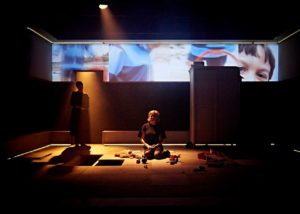
Credit: Little Wolf / Lucid – Av mapping by Jorge Lizalde | studiocano.co.uk
Get the Chance works to support a diverse range of members of the public to access cultural provision Are you aware of any barriers to equality and diversity for either Welsh or Wales based artists/creatives?
Yes I am really aware, I am Spanish and have an accent that in many cases is judged as not educated or a knowledgeable person. I haven’t been able to get some jobs because of it. At the beginning it was annoying when people tried to maximise their mouth motion and slow their pronunciation when talking to me because they think I didn’t understand but now I just do the same to them if they do, I slow my talking and maximise my pronunciation, maybe that’s why I don’t get the jobs but who wants to work with someone that diminishes you by your accent? Also, I have been involved with Taking Flight Theatre Company
As well as other theatre companies developing live subtitles, I have been working on creating theatre which is more accessible to all audiences. I believe I am the only person in the UK using the software I am working with, or at least this is what a programmer recently told me! It is software created for film cinema subtitles but I adapted to theatre. It can be projected over projections, it can be programmed to be part of the stage and interact with actors, it can be shared in any device, Android or Apple, phone or pads and via a local network which can be used in a promenade performance without access to the internet. In addition I am developing live speech to text subtitles (same language or a live translation of it as for example Welsh-English or Spanish- English) but the technology is not there yet, hopefully with the development of home assistants like Google Home and Amazon Alexa the interpretation of the language will get faster and better.
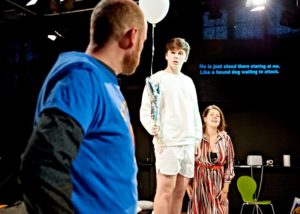
Credit: Yuri / August 012 | Subtitles and picture by Jorge Lizalde | studiocano.co.uk
There are a range of organisations supporting Welsh and Wales based artists and creatives, I wonder if you feel the current support network and career opportunities feel ‘healthy’ to you?
I think it is pretty healthy, a bit more funding would be great, especially after so many years of having cuts in the arts budgets. The only problem I am facing this days is, I am in my late 30s so there are no prizes or opportunities for that age or not as many, most are focused on early career or under 30s. If you are a mid 30s or early 40s creative and want to start an art career there are not many opportunities to build a good portfolio and be quickly part of the art community.
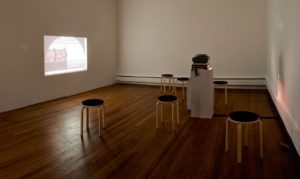
Credit: Own Installation, “Editing my father” at Ffotogallery
If you were able to fund an area of the arts in Wales what would this be and why?
To choose an specific area would be to discriminate against the others. I never understood targeting specific areas, all areas, race, social, cultural backgrounds, etc should be considered every year for equally and fund them according to the excellence of the projects and their outcomes. If that means some stablished organisations loose funding after many years receiving it because independent or small projects are creating better projects to present, so be it.
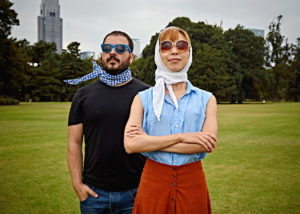
Credit: “Cymru & I” Collaboration with Japanese choreographer Yo Nakamura
More information about the project linked to the above image: http://jorgelizalde.com/iframe-2/iframe/index.html
What excites you about the arts in Wales?
What really excites me it is the size of the art community, it is not big, so you soon know most of the artists working in Wales. This also makes it really accessible, and that gives you great freedom to experiment and collaborate with other artists and start new projects or enterprises. It creates opportunities for pop up exhibitions, zines, performances, etc. I don’t think there are enough links with work which is part of a performance or the theatre/artistic community with visual or more modern arts groups but hopefully in the future there will be more collaborative work between art galleries – g39, Ffotogallery and Chapter – with the performance festivals – Festival of Voice, Cardiff Dance Festival – or venues like the WMC or Chapter – as well as artists from both backgrounds. When they have collaborated in the past at events such as Experimentica or Artes Mundi there are more interesting projects happening and everybody really gains from it, creatively and culturally.
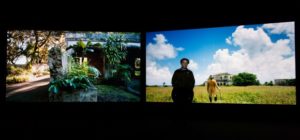
Artes Mundi 2017 Winner John Akomfrah with artwork Auto Da Fé © Polly Thomas

Credit: “1865” prototype game app in collaboration with Yellobrick, Nesta and National Library of Wales
Link to more information on the project above https://www.nesta.org.uk/our-projects/digital-rd-fund-arts-wales-case-studies/arts-archives-and-technology
What was the last really great thing that you experienced that you would like to share with our readers?
I have always been interested on working with lights and mapping lights structures these are getting more and more interesting, especially with LEDs stripes, with them you can have as many different colours and sync as you like. A good example of it is Robert Hencke’s Lumiere III laser lights installation which I saw at the Barbican main theatre at the beginning of this year and it was one of the greatest art experiences I have ever seen.
Thanks for your time Jorge.
You can find more information about Jorge and his work at the links below.
Personal
Commercial
